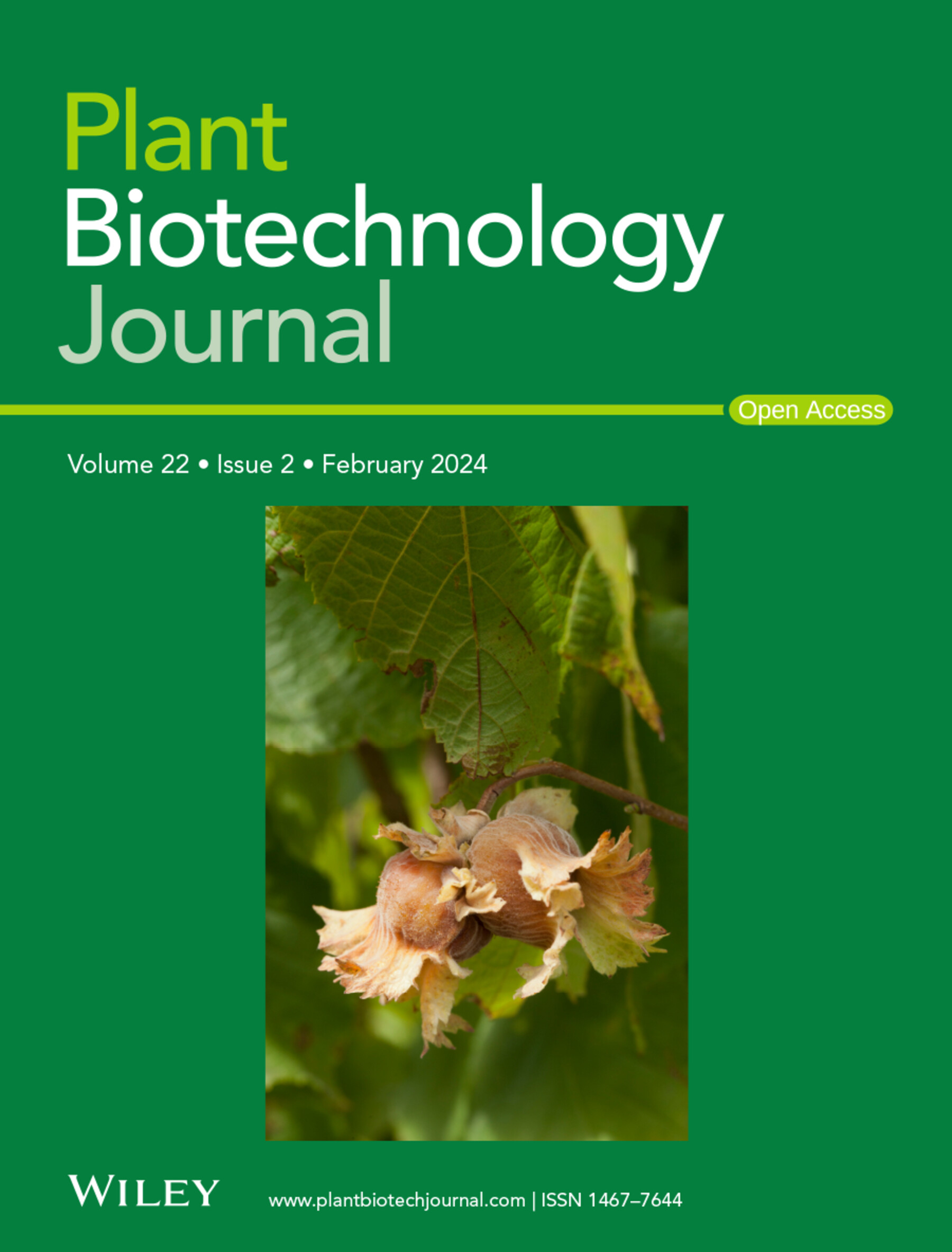Immunity gene silencing increases transient protein expression in Nicotiana benthamiana
IF 10.1
1区 生物学
Q1 BIOTECHNOLOGY & APPLIED MICROBIOLOGY
引用次数: 0
Abstract


免疫基因沉默增加烟叶瞬时蛋白表达
农杆菌(Agrobacterium tumefaciens)浸润本烟(Nicotiana benthamiana)已成为植物科学和分子药剂学的常规表达平台,但该平台仍有待进一步优化。我们最近发现,对冷休克蛋白(CSP)受体(CORE)沉默的N. benthamiana在年龄较大的6 - 8周的植物中能够多产生8倍的GFP,而这些植物通常不会被使用,因为它们的瞬时表达效率较低(Dodds等,2023)。在这里,我们研究了我们是否也可以通过沉默免疫相关基因来增加常规使用的5周龄幼嫩植物的瞬时蛋白表达水平。我们选择了21个免疫相关基因,编码在植物免疫系统中不同水平起作用的蛋白质(表S1)。除CORE外,我们还沉默了受体编码基因WAK1(壁相关蛋白激酶)、CERK1(几丁质激发子受体激酶-1)、BAK1 (bri1相关受体激酶-1)、SOBIR1 (BIR1-1抑制因子)和RE02 (scp受体)。我们还测试了免疫信号成分如F-box蛋白ACIF1 (Avr/ cf诱导的F-box-1)的沉默;脂酶样蛋白EDS1(增强疾病易感性-1)和SAG101(衰老相关基因-101);CDPK(钙依赖性蛋白激酶),MPK3/6 (MAP蛋白激酶-3和-6),nod样辅助受体NRC2/3/4 (Cf信号必需的NLR)和伴侣蛋白CRT3a(钙网蛋白-3a)。我们还纳入了应激激素信号传导所需的基因,包括PAL(苯丙氨酸氨裂解酶)、ICS(异氯酸合成酶)、NPR1 (PR基因非表达者-1)、EIN2(乙烯不敏感-2)和WRKY转录因子。最后,我们纳入了编码拟南芥H+- atp酶2 (AHA2)和RBOHB(呼吸爆发氧化酶同源物B)的基因,编码植物烯去饱和酶(PDS)和ß-葡萄糖醛酸酶(GUS)的基因分别作为沉默的阳性和阴性对照。我们重新合成了先前发表的沉默片段(表S1),并选择了针对ACIF1、CDPK、CORE、ICS和AHA2的新片段(Dodds等人,2023,表S2和S3)。将烟草响尾蛇病毒(TRV)载体分别携带这21个免疫基因片段和对照基因片段,并在2周龄的幼苗中进行农渗透,3周后检测植株的瞬时表达。新的沉默片段下调了靶基因的转录水平(图S1)。在这一阶段,除了TRV::PDS植株、矮化的TRV::BAK1和TRV::CDPK植株以及小的、褪绿的TRV::ICS植株出现光漂白现象外,TRV::PDS植株未观察到强表型(图S2)。flg22处理后,TRV::RBOHB和TRV::BAK1植株的叶片氧化爆发减少(图S3),这与这些基因的有效沉默一致。沉默的植物被1:1:1的混合农杆菌浸润,农杆菌携带三种“红绿灯”报告器:生物发光的AgroLux细菌(Jutras et al., 2021,橙色),混合农杆菌携带细胞核GFP(绿色)和分泌RFP(红色)的表达盒。与TRV::GUS植株相比,TRV::ICS、TRV::CERK1、TRV::NPR1和TRV::EIN2植株浸润后5天(5 dpi)叶片的GFP荧光显著升高(图1a)。与TRV::GUS对照植株相比,同样沉默的植株也显示出更多的RFP荧光(图S4a)。在TRV::CORE植株中未检测到荧光变化,这与幼植株中CORE低表达一致(Wang et ., 2016)。这些被沉默的植物之间的AgroLux生物发光相似(图S4b),表明沉默这些免疫基因不会增加农杆菌种群水平。在随后的实验中,对agro浸润叶片的扫描证实,与GUS沉默对照相比,沉默CERK1或NPR1使gfp荧光增加了4倍,ICS沉默使gfp荧光增加了10倍(图1b,c)。此外,与TRV::GUS植物相比,在TRV::EIN2中检测到的GFP荧光显著增加了1.7倍(图S5),与初始筛选结果一致。图1在图视图中打开powerpoint .群落基因沉默增加了烟叶的瞬时表达。(a)在两种不同的实验中,用携带21个免疫基因片段的烟草摇铃病毒(Tobacco Rattle Virus, TRV)接种两周龄的benthamiana植株。3周后,用携带表达胞质GFP、分泌RFP和生物发光AgroLux细菌二元载体的农杆菌以1:1:1的比例浸润体表叶片。在5 dpi下取叶片,进行GFP荧光分析。误差条表示n = 4(上)和n = 12(下)个重复的SE。数据采用Dunnett事后检验的方差分析。*P < 0.05;***P < 0.01;****P < 0.0001。(b)沉默CERK1、NPR1和ICS可增加瞬时GFP表达。枚N。两星期 用携带多种靶基因片段的烟草摇铃病毒(Tobacco Rattle Virus, TRV)接种本菌属植物。3周后,用农杆菌携带表达GFP的二元载体对植物进行农浸润,在5 dpi时拍摄图像并定量。(c) (b)中检测到的GFP荧光定量。误差条表示n = 4个重复的SE。Dunnett多重比较检验的方差分析。(d) CERK1、ICS和NPR1在抑制瞬时基因表达中的可能作用。CERK1是一种受体样激酶,可能感知肽聚糖(PGN)。异氯酸合成酶(ICS)是一种在叶绿体中产生水杨酸(SA)前体的代谢酶。非PR1表达者(NPR1)调节激活免疫基因的转录因子(TFs)。(e) npr1a/npr1b双突变体瞬时GFP表达增加。瞬时表达不含P19的GFP,在5 dpi处进行荧光成像(左),定量(中),并对叶提取物进行抗GFP western blot分析(右)。误差条表示n = 18个重复的标准差。观察到的效应表明,免疫基因CERK1、NPR1和ICS编码了瞬时表达的重要屏障(图1d)。CERK1是一种受体样激酶,参与感知几丁质(Miya et al., 2007)和肽聚糖(Willmann et al., 2011)。NPR1是水杨酸(SA)诱导应答的转录调节因子(spel and Dong, 2024)。ICS是一种产生异氯酸盐的叶绿体酶,异氯酸盐是SA的前体(Spoel和Dong, 2024)。在TRV::PAL植物中,GFP荧光未发生改变,表明限制瞬时表达的SA不是通过苯丙氨酸产生的,而是通过agro浸润叶片中的等氯酸盐产生的(Spoel和Dong, 2024)。ICS沉默的效果是NPR1沉默的两倍,这可能是因为ICS消耗不仅会减少免疫信号传导,还会降低对农杆菌中vir基因表达产生负调控的SA水平(Yuan等,2007)。为了在不依赖VIGS的情况下增强瞬时表达,我们正在使用基因组编辑和堆叠突变基因来破坏这些免疫相关基因的开放阅读框。到目前为止,两个沉默的NPR1基因的缺失(图S6)确实引起了GFP荧光和积累的增加(图1e)和IgG积累的增强(图S7)。这些基因组编辑的细胞系在促进benthamiana蛋白质生产的瞬时基因表达方面具有重要的潜力。
本文章由计算机程序翻译,如有差异,请以英文原文为准。
求助全文
约1分钟内获得全文
求助全文
来源期刊

Plant Biotechnology Journal
生物-生物工程与应用微生物
CiteScore
20.50
自引率
2.90%
发文量
201
审稿时长
1 months
期刊介绍:
Plant Biotechnology Journal aspires to publish original research and insightful reviews of high impact, authored by prominent researchers in applied plant science. The journal places a special emphasis on molecular plant sciences and their practical applications through plant biotechnology. Our goal is to establish a platform for showcasing significant advances in the field, encompassing curiosity-driven studies with potential applications, strategic research in plant biotechnology, scientific analysis of crucial issues for the beneficial utilization of plant sciences, and assessments of the performance of plant biotechnology products in practical applications.
 求助内容:
求助内容: 应助结果提醒方式:
应助结果提醒方式:


